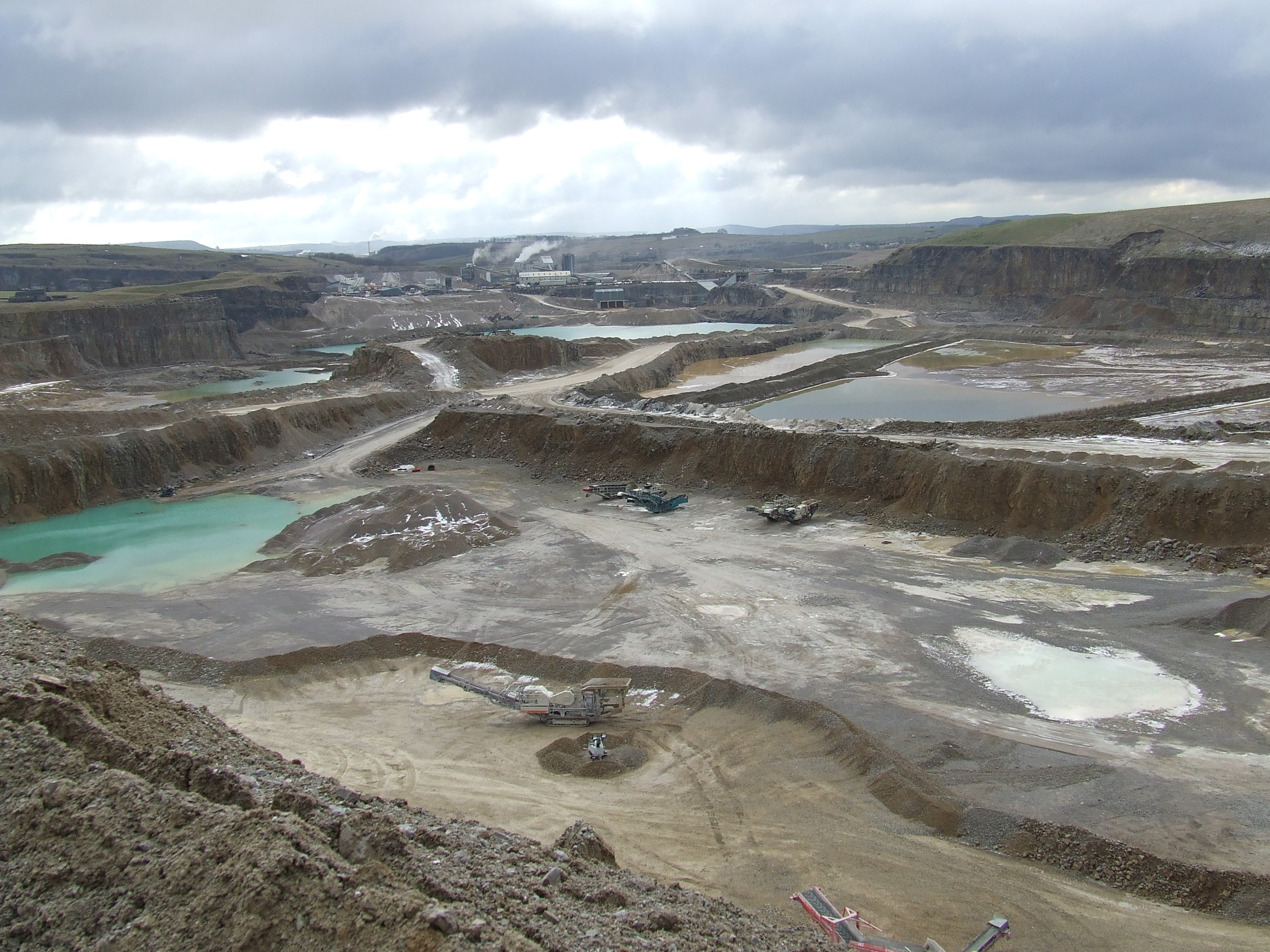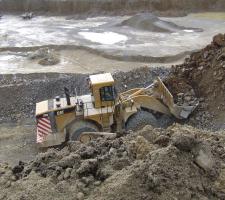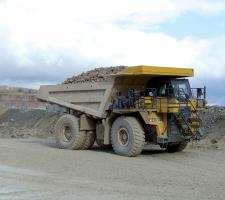
Investment in centrifuges at Cemex's Dove Holes Quarry is set to improve washing processes and open up access to reserves. Claire Symes reports
The hills and countryside of Derbyshire in the UK makes it a popular destination for tourists and in June, the quarry industry will also be heading there for the
Quarrying has been underway at Dove Holes Quarry for over a century and with another 250million tonnes of reserves, work is set to continue well into this century. Access to these reserves is now being made possible through a recent £2.3million (e2.6million) investment in a centrifuge plant to manage waste washing water and remove the need for space-consuming settlement ponds.
History
Dove Holes Quarry - named after the local village - extracts Carboniferous limestone from the Chee tor formation. The rock is massive, pale grey in colour and chert free and has a very high purity with over 98.5% calcium carbonate.
"The quarry was privately owned in the early 1900s by a company called Taylor Frith. RMC, which later became part of Cemex, bought the quarry in 1983 when it produced 2million tonnes per year," said Dove Holes Quarry engineering maintenance manager Steve Leigh.
The quarry reached its peak production in 2008 at 4.2million tonnes. This fell back slightly to 3.5million tonnes in 2009 as a result of the impact of the economic downturn, but Leigh is confident that demand will return to around 4million tonnes this year.
Leigh's own career in quarrying started at Dove Holes quarry when he joined as an apprentice in 1974, although he left to work for another company for a brief period in the 1980s, he later returned to take on a management role. "Quarrying runs in my family so it was a natural industry to move into," he said.
Dove Holes is formed from three smaller quarries - Beelow, Peak and Holderness - and covers an area of 213ha with 250million tonnes of reserves. Towards the north eastern edge of the main quarry, there used to be a marsh and deposits in this area contain a high level of clay bands in the upper rock formations.
The quarry is the second largest in the region but is the largest globally within Cemex and employs 120 staff.
"The three parts of the quarry will be amalgamated within 15 years as we open up the reserves," explained Leigh. "We will work out to the boundaries and then work downwards from there." The final depth of the quarry is very dependent on groundwater - the quarry already pumps 1million gallons of water per day from the site. "The water is potable but we use it for on site processing or discharge it back into the river network," said Leigh.
In addition to the aggregate production, the quarry is also home to an asphalt plant producing 200,000tonnes per year, a dry silo mortar production of up to 100,000tonnes per year and there are two concrete products and one ready mixed concrete plants on site that are operated by another division of Cemex.
Material from the site is transported over a wide area thanks to the on-site rail head from which around 55% of the aggregate is transported. The rest is moved by truck using Cemex's own fleet of on-highway haulage trucks or by customers collecting their own materials.
"The rail links mean that material from Dove Holes is transported to a large number of depots, including Crawley, Bletchley, Ely, Manchester, Selby, Washwood Heath, Norwich, Leeds, Hitchin and Sheffield," said Leigh. "We also take granite aggregates to Sturton from our Gilfach quarry.
"Truck deliveries are generally limited to a 60km radius but we do sometimes go further to meet a specific order. The trains are much more efficient though as each one can transport 15,000 to 17,000tonne each time."
Extraction
Drilling is carried out using an
"Below contains the best rock but the deposits in Peak are dirty with more clay pockets so the design has to take account of this," said Leigh. "We blast two to three times a week and generally produce between 40,000 and 50,000tonnes each time." Blasting is carried out under contract by Orica, which uses slurry emulsion explosives with Nonel detonators. "We tried the computer-based Icon system for a while but it did not prove to be cost effective," explained Leigh.
Blasted material is loaded at the face using either the quarry's
"These are the first Komatsu machines we have had at Dove Holes, before that our fleet was exclusively Cat machines, which have performed very well over the years," said Leigh. "A number of our Cat machines have been through the certified rebuild programme, so the Komatsu machines have a lot to live up to." The most recently rebuilt Cat machines were the 775 truck, which underwent reconstruction in November 2008 when they had reached 17,000hours of operation after five years work in the quarry.
DRILLING
Sandvik D600 rig
FACE LOADING
Komatsu WA800 wheeled loader Cat 990 wheeled loader
HAULING
3x Cat 775D rigid dump trucks
3x Komatsu 605 rigid dump trucks
PRIMARY CRUSHING
1x Roltech Engineering Apron feeder
1x Hazzemag Roll Grizzly
1x Sheepbridge 72" x 72" Double rotor impact crusher
SECONDARY CRUSHING
1x Sheepbridge 4462 variable speed reversible impactor
1x 12-12-4 620 RPM SBM fixed hammer impactor
SCREENING
8x Don Valley screens
WASHING
2x Wileman 3300 x 700 washing barrels
2x Don Valley washing screens
2x Don Valley dewatering screens and Linatex cyclones
TRUCK LOADING
2x Cat 980G wheeled loader
1x Volvo 220
4x direct loading points
CUSTOMER DELIVERY
20x on-highway trucks
89x bottom discharge rail trucks
(Owned by DB SCHENKER)
ASPHALT PLANT
1x Bristowes B120 asphalt plant
1x Via Nova batch plant
Crushing and screening
Material over 1.5m is loaded at the face and stored on site for specialist rock armour contracts - the quarry recently supplied a large volume of edge protection boulders to the Alderley Edge Bypass. The rest of the material is hauled to the fixed primary crushing plant.
Most of the primary crushing and screening plant dates back to 1974. The installation features a 150tonne hopper over an apron feeder with an 1800tonnes per hour capacity. A live roll grizzly sorts the 0 to 125mm material and sends it to the washing plant and any material over 125mm is fed into the 1000tonnes per hour double rotor impactor primary crusher, which reduces material in the 1.5m to 250mm range.
Secondary crushing is carried out by a 500tonnes per hour Sheepbridge swing hammer with a variable speed impactor featuring 100mm grid bars and a 250 tonne per hour SBM fixed hammer impactor with variable gap setting. The secondary process reduces aggregates to below 75mm.
Aggregates are screened into eight different sizes using eight screens operating two streams with a mix of rubber and wire meshes to produce the quarry's standard aggregate range.
Washing investment
Dove Holes' washing plant comprises two 7m long, 3.3m diameter Wileman washing barrels which give a 1200tonnes per hour capacity. "The plant was built by Don Valley in 1999 to replace an old plant and better deal with the dirty material coming from the marsh area of the quarry," explained Leigh.
"The washing plant uses around 800tonnes per hour of water but this is supplied by the groundwater pumped from within the site." Material coming from the barrels is passed over two washing screens to remove the larger lumps and put through cyclones to recover the sand particles, but material below 75 microns stays within the suspension. "The volume of these solids can vary considerable depending on where the stone has come from in the quarry," explained Leigh.
However, the high throughput meant that dealing with the slurry was a problem and the necessary large lagoons were sterilising some of the quarry's reserves.
"Some of the lagoons were taking three years to dry out and were filling faster than they were drying," said Leigh. "The washing process was producing 250,000tonnes of clay slurry each year and another 400,000tonnes of slurry waste had to be tipped or stored each year." Cemex originally looked at filter presses but the cost was considered too high to meet the demand from the washing plant, so the company looked into the possibility of using centrifuges instead.
The real benefit of the centrifuge system was that it is continuous and can be ramped up as production varies," said Cemex mechanical engineering project manager Bob Ingle. "Our primary crusher operates from 6am to midnight, but the secondary plant operates 24 hours a day, so we needed a system that could be automated and match the demand.
A filter press could have been designed to cope but we would have needed at least four, which would have been expensive and large too. The centrifuges are more compact and can be automated to switch on and off with the varying amount of solids."
Dove Holes has six CQ7000 centrifuges that were installed by Centriquip. The system features a density metre to switch the centrifuges on and off as needed in order to optimise the operation and keep energy consumption to a minimum.
Work on installing the new plant started in January 2008 but it was quickly realised that a larger, more efficient flocculent system was needed. The selected plant from France-based polymer manufacturer SNF was commissioned in December last year, clearing the way for final commissioning of the centrifuge plant. The flocculent system features a double tank with a 15m3 mixing tank fixed above a 15m3 holding tank below, as well as a bulk bag loading system to minimise manual handling.
With the new system in place, Cemex hopes to be able to start decommissioning the settlement ponds over the next few years. "The wet climate in Derbyshire means that they will take some time to dry out but once the silt has been dug out, we will be able to open up the reserves more easily," said Leigh.
Natural protection
Despite being close to the Peak National Park the quarry faces very few environmental challenges. "We invested fairly heavily in improving systems at the quarry five years ago," explained Leigh.
The only issue that the quarry does have to contend with is a family of badgers. "After a lot of consultation, we built a new badger sett for the family but all that happened was that the older ones stayed in the old sett, while the youngsters set up home in the new sett sor for a while we had two colonies instead of the original single one," said Leigh. "We do have to keep an eye on the badgers - they are a protected species - but we do have problems sometimes with badger baiters trespassing on the site."
The quarry is surrounded by a number of public footpaths and bridleways, so the company is carefull to ensure fences are well maintained and there are signs to warn people of the danger of trespassing.

















